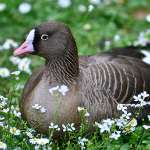Estonia’s newest Ramsar Site protects 2 million birds migrating over the Baltic Sea8th March 2012  Estonia has designated its 17th Wetland of International Importance - Haapsalu-Noarootsi - a wetland complex situated on the northwestern coast along the Baltic Sea with inlets and bays, coastal lagoons, coastal meadows, and reedbeds as well as mud- and sandflats. Estonia has designated its 17th Wetland of International Importance - Haapsalu-Noarootsi - a wetland complex situated on the northwestern coast along the Baltic Sea with inlets and bays, coastal lagoons, coastal meadows, and reedbeds as well as mud- and sandflats.
Haapsalu-Noarootsi is an important wintering, staging, moulting and breeding site for 225 different bird species, including Long-tailed Duck Clangula hyemalis, Common Eider Somateria mollissima and globally threathened Lesser White-fronted Goose Anser erythropus. At least 20 percent of the water birds migrating over the Baltic Sea (up to 2 million individuals) pass through this site. It is also one of the biggest spring spawning grounds in western Estonia for freshwater fish such as Pike Esox lucius.
Threats to the site include the overgrowing of coastal grasslands due to abandonment, impacts of waste water from Haapsalu town, and an increase in invasive alien species. Two conservation projects have recently been carried out in the site to restore valuable habitats and enhance ecotourism facilities. A Nature Information Centre has been established and the site can be visited for hiking, bird watching, camping, and boat trips.
More information is available on the Ramsar website
|